LAS VEGAS (Day 3 - part 6)
The Linq Promenade, an collection of bars, restaurants, and stores, was opened in 2013.



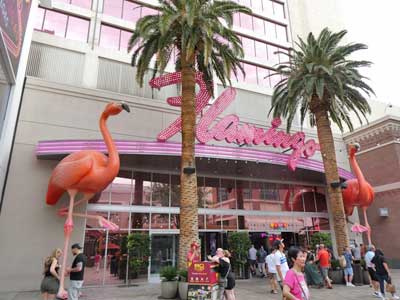


Sean wanted to watch a sports game, so I took the opportunity to wander. Directly across the street was Caesars Palace, so I started there.



A 20-foot Augustus Caesar even gets into the act. The original statue, Augustus of Prima Porta, dates back to around 14 AD and was discovered in 1863 in a town near Rome. Cupid stands at his feet.


Caesars Palace (founded in 1966) is a massive complex with many different sections, including a casino, hotel (six towers and a convention facility), an indoor shopping mall (The Forum Shops) and an entertainment venue (The Colosseum).

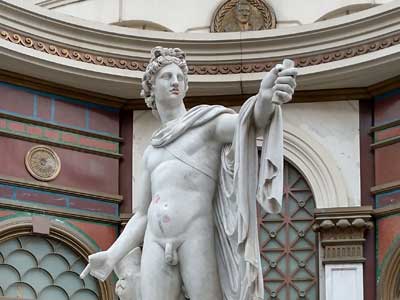




A copy of Trevi Fountain graces one side of the indoor shopping area. The original 1762 Baroque fountain, La Fontana di Trevi (meaning three roads, since three roads used to meet there), stands in the Trevi district in Rome.

In the center is Oceanus. Standing on his shell-shaped chariot, he's being pulled by two winged horses and tritons (young gods of the sea). The horses symbolize the changing tides... one is peaceful while the other is rambunctious. The two statues in the niches represent Abundance (left) and Health.
Oceanus, Neptune or Poseidon? What's the difference?
Poseidon was the Greek god of the seas and Neptune was his Roman equivalent. While Poseidon (who is usually depicted holding a trident) was able to control the seas, Oceanus represented the sea itself. Oceanus was also a Titan, a much earlier god more connected with the formation of the world.
In the beginning, there was the primordial god of the sky and the goddess of the earth. Their children were known as the Titans. And their children were the 12 Olympian gods (Zeus, Hades, Poseidon, Demeter, etc). In a 10-year war, the newer Olympian gods overthrew the older Titans. Then again, the Titans had overthrown their parents, so it was nothing really new.



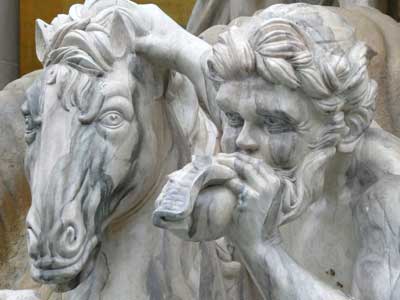
Oceanus ... A triton blows a shell to announce their passage.


Abundance with a cornucopia .... Health holds a cup from which a snake drinks.

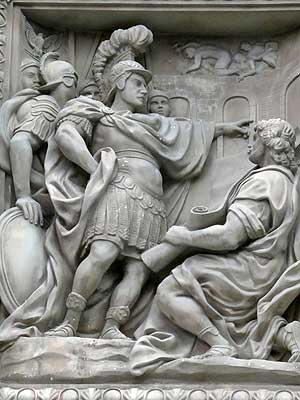
Other scenes also decorate the facade.
(Left) Marcus Agrippa was returning from a long battle and his troops were dying of dehydration. A young girl (virgo in Latin) showed them where they could get fresh water.
(right) Agrippa decided to build an aqueduct (named Aqua Virgo) from the water source into Rome. Here, he approves the architectural plans for the aqueduct (which is being built in the background). The real Trevi Fountain sits at the aqueduct's endpoint.


Statues stand at the top of the fountain. In the real Trevi fountain, these figures are female.


A row of trumpeting angels in front of The Colosseum ... and viewed from the other side, in front of one of entrances to The Forum.


I headed into the mall with its over 150 shops. Spiral escalators, numerous fountains, marble floors, painted ceilings, giant columns and endless details, the three-level Forum was intended to give one the feel of ancient Rome and Renaissance Italy. It was built as an extension of the main hotel and casino in 1992.




The ceiling


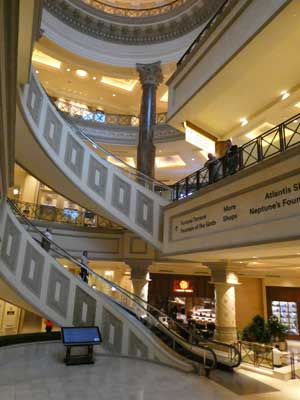

Spiral escalators were first developed by Mitsubishi Electric in 1985. Installing this one presented many challenges. The design had to match the curve of the building while allowing unobstructed views of the shops. A steel support base was built and then made to look like stone. The escalators appear suspended in mid-air as they gracefully curve their way between floors.




The statues don't look that big ... until one gets a sense of scale

Heading into the next section of the mall
return • continue

